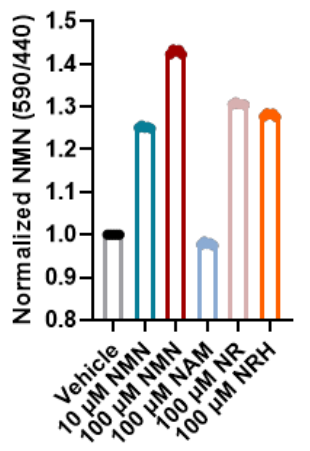Scientists have developed a new sensor-based testing method to measure the levels of NAD+, NADH, NMN, and NR in cells. This study reported new insights into the uptake and metabolism of NAD+ precursors.
“Given that NMN is a primary precursor of NAD+, mapping subcellular NMN is important for the comprehensive understanding of NAD+ metabolism.”
Key Points
- NMN was the most effective for boosting NMN levels in cells vs NR and NAM
- Some NMN entered cells directly through a transporter called Slc12a8
- NAD+ precursor metabolism varied in different cell types
NMN Most Effective NAD+ Precursor for Raising Cellular NMN
The researchers found that NMN uptake was very rapid, increasing NMN levels in the cell within 4 minutes after administration.
NMN was also more effective at boosting NMN levels than other NAD+ precursors, such as NR and NAM.
“Among the tested conditions, extracellular NMN is the most efficient precursor in boosting cytosolic NMN.”

This figure shows the levels of NMN in cells treated with different NAD+ precursors (NMN, NAM, NR, and NRH). Vehicle (gray bar) represents cells not exposed to any NAD+ precursors and serves as a control. NMN (100 µM, red bar) was the most effective precursor at boosting NMN levels.
Some NMN Entered Cells Directly
It is known that NMN is a key player in boosting NAD+ levels. However, how NMN gets into cells is not fully understood.
Scientists have identified two main ways that NMN can enter cells:
- Indirect entry: NMN transforms into NR, enters the cell, and then changes back into NMN.
- Direct entry: A special NMN transporter, called Slc12a8,can carry NMN directly into the cell.
A 2019 study identified Slc12a8, but its exact role in NMN metabolism has remained unclear. This study further showed that Slc12a8 helps transport NMN into cells.
“The Slc12a8 overexpression led to an increased rate of cytosolic NMN concentration change after adding 100 μM of extracellular NMN.”
They confirmed that there are multiple ways for NMN to get into cells.
“NMN uptake in HEK 293T cells is not solely dependent on NR-NRK conversion and that NR and NMN employ distinct mechanisms for cytosolic NAD+ regulation.”
NAD+ Precursor Metabolism Varied in Different Cell Types
The researchers studied how cells in the kidney, fat, and liver use NAD+ precursors.
They found NRH acted differently in liver cells compared to the other cells, suggesting that different cells may have unique ways of handling these precursors.
“However, there was no significant change observed after incubating HepG2 cells with NRH, indicating the potential cell-type specificity of the precursors.”
Conclusion
This study demonstrated a new method to track NMN metabolism in cells.
“In this study, we successfully designed the first genetically encoded NMN sensor for its quantification in live cells.”
NMN was the most effective NAD+ Precursor for raising NMN levels in cells.
“We observed that NMN can induce immediate and dose-dependent cellular responses.”
The researchers confirmed that some NMN is transported into the cells directly through Slc12a8.
“Based on these observations, we speculate that NMN can be directly taken up by HEK 293T cells, meanwhile the indirect NR-NRK pathway also contributes to the NMN uptake.”
